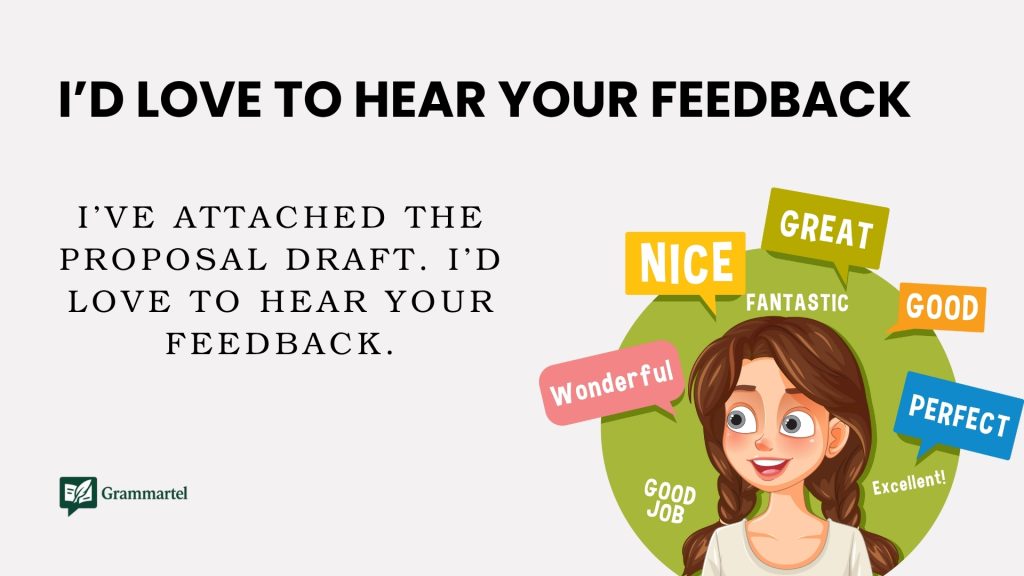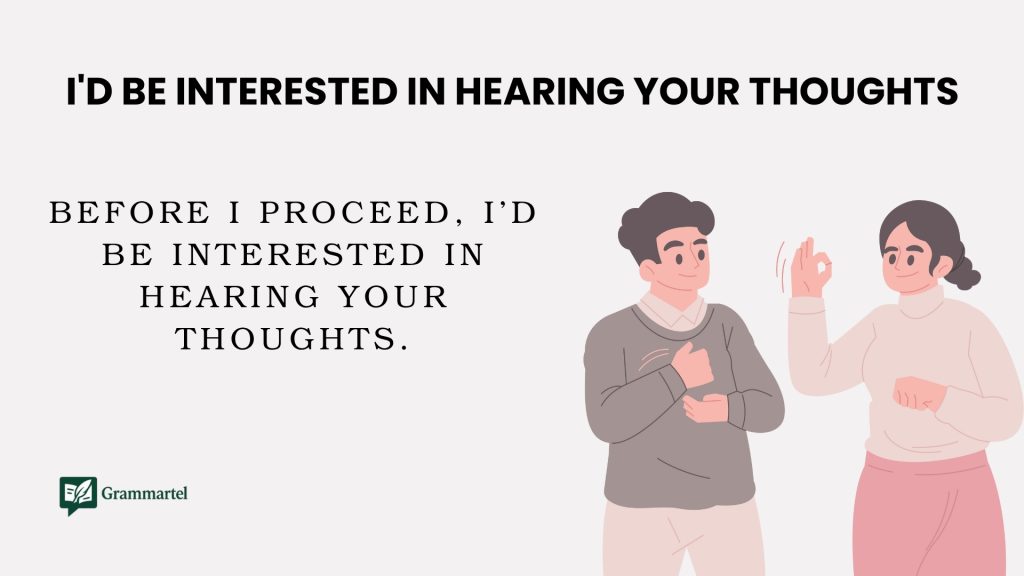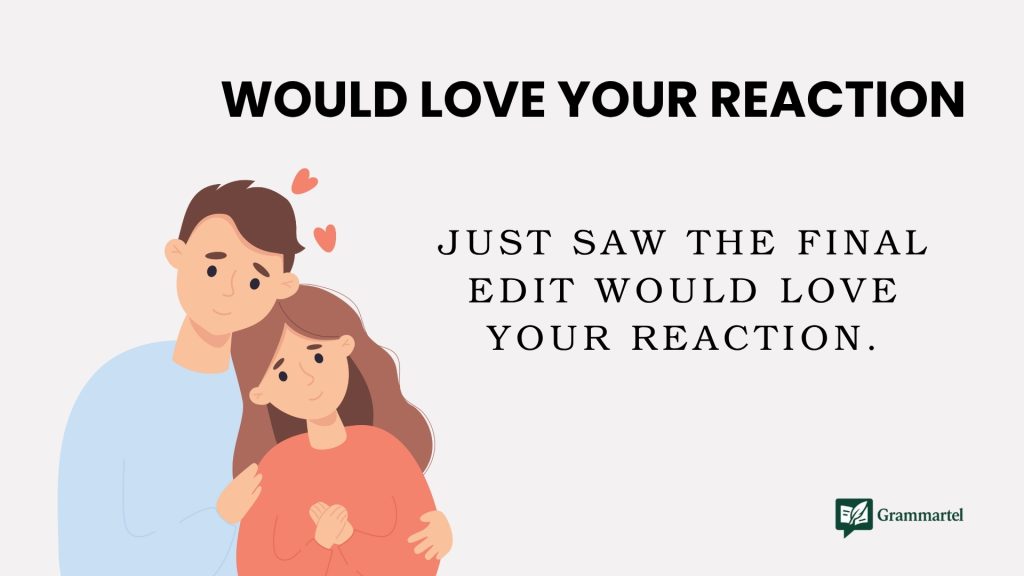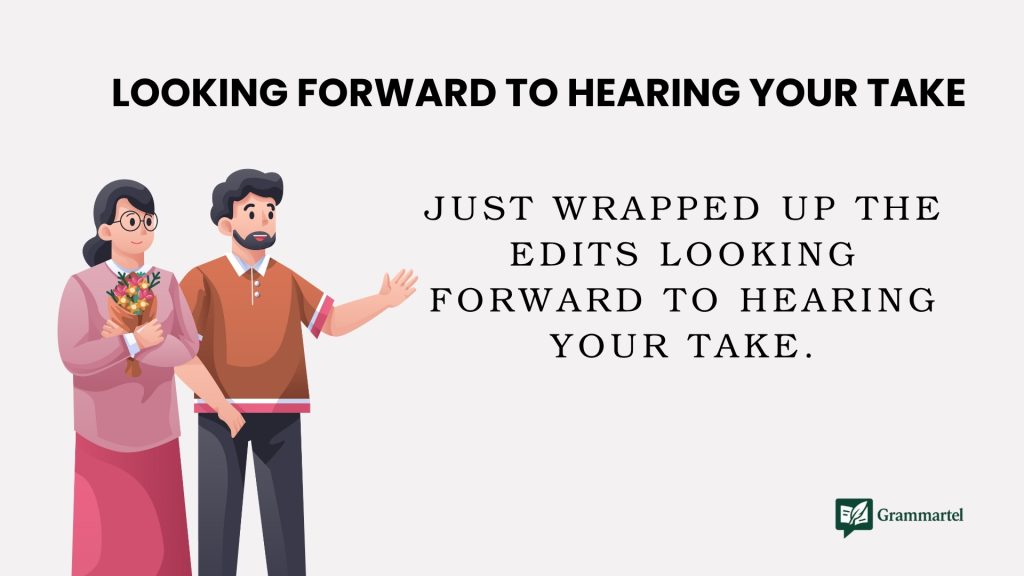Ever find yourself typing “Please let me know your thoughts” for the hundredth time in an email? You’re not alone. It’s a polite phrase, sure—but it can start to feel dull or overused, especially in work messages or when you’re hoping for honest feedback. The good news? There are plenty of fresh and friendly ways to ask someone what they think. Whether you’re chatting with a client, teammate, or even a friend, switching things up can make your message feel more personal, more natural. In this list, you’ll find 40 clear and easy alternatives, each with simple examples.
What Does “Please Let Me Know Your Thoughts” Mean?
This phrase is a polite way to ask someone for their opinion. It shows that you care about what they think. You might use it after giving an idea or sharing a plan. It invites the other person to share feedback, ask questions, or agree with you. It’s often used in emails or messages at work or school. It helps keep the conversation open and respectful. Saying this shows that you are open-minded and want to hear from others before moving forward.
When to Use “Please Let Me Know Your Thoughts”
Use this phrase when you want feedback or advice. It’s perfect after you share ideas, send a draft, or suggest a plan. You can use it in emails, messages, or even in person. It works well in both formal and casual talks. If you want someone to review your work or help you decide, this is a kind way to ask. It shows respect and teamwork. Just make sure the other person has enough details to reply. Then, this simple phrase can help start a great exchange.
40 Alternatives Ways to Say “Please Let Me Know Your Thoughts”
1. I’d love to hear your feedback

Meaning: I’m interested in your opinion.
Explanation: A warm, engaging way to invite comments or suggestions.
Example: I’ve attached the proposal draft. I’d love to hear your feedback.
Best Use: Team collaboration or creative reviews.
Worst Use: Formal legal or contractual discussions.
Tone: Friendly, open
2. What are your thoughts on this
Meaning: What do you think about this?
Explanation: Direct question asking for someone’s opinion.
Example: We’re thinking of adjusting the timeline. What are your thoughts on this?
Best Use: Brainstorming or planning sessions.
Worst Use: Highly formal corporate communication.
Tone: Conversational, curious
3. Do you have any input
Meaning: Do you want to contribute any ideas or feedback?
Explanation: Invites engagement and participation.
Example: Before we finalize, do you have any input?
Best Use: Internal decision-making.
Worst Use: Customer-facing situations.
Tone: Neutral, inclusive
Don’t miss : 40 Other Ways to Say “Can’t Wait” (With Examples).
4. Feel free to share your perspective
Meaning: You’re welcome to express your viewpoint.
Explanation: Encourages openness without pressure.
Example: I understand this might be sensitive. Feel free to share your perspective.
Best Use: Collaborative or sensitive discussions.
Worst Use: Time-sensitive or urgent issues.
Tone: Supportive, respectful
5. Let me know what you think
Meaning: Tell me your opinion.
Explanation: A very casual and commonly used phrasing.
Example: I put together some slides—let me know what you think.
Best Use: Casual conversations or informal reviews.
Worst Use: Highly professional or diplomatic emails.
Tone: Casual, relaxed
6. I welcome your suggestions
Meaning: I’m open to your ideas or improvements.
Explanation: Invites constructive criticism or enhancements.
Example: Before we move forward, I welcome your suggestions.
Best Use: During early planning or proposal stages.
Worst Use: Final stages where feedback won’t change much.
Tone: Respectful, collaborative
7. I’d appreciate your thoughts
Meaning: I’d value your opinion.
Explanation: Polite and shows deference to the recipient.
Example: This draft is still rough—I’d appreciate your thoughts.
Best Use: Peer or supervisor input.
Worst Use: Fast-paced, casual interactions.
Tone: Polite, sincere
8. Any thoughts
Meaning: Do you have anything to add?
Explanation: Very informal and succinct way to ask for input.
Example: Here’s my take. Any thoughts?
Best Use: Text or chat communication.
Worst Use: Formal email or document.
Tone: Informal, brief
9. Does this make sense to you
Meaning: Do you understand this and agree?
Explanation: Checks both understanding and acceptance.
Example: We’ll move forward with Option A—does this make sense to you?
Best Use: Follow-up instructions or action plans.
Worst Use: When only looking for feedback, not clarity.
Tone: Clarifying, polite.
10. Would love your input
Meaning: I value your ideas.
Explanation: Short and friendly request for contribution.
Example: Planning a team retreat—would love your input.
Best Use: Collaborative and creative environments.
Worst Use: Legal, compliance-heavy contexts.
Tone: Casual, friendly
11. I’m open to your feedback
Meaning: I’m willing to consider your opinion.
Explanation: Signals flexibility and openness to improvement.
Example: I’ve drafted a new outline—I’m open to your feedback.
Best Use: Early-stage proposals or reviews.
Worst Use: Situations requiring a firm stance.
Tone: Open, receptive
12. Let me know your take
Meaning: Share your perspective.
Explanation: Casual way to ask for a quick opinion.
Example: Here’s the updated version. Let me know your take.
Best Use: Peer-to-peer or informal team communication.
Worst Use: External client correspondence.
Tone: Informal, friendly
13. I’d value your opinion
Meaning: I consider your viewpoint important.
Explanation: Shows respect and esteem for the recipient’s insight.
Example: I’d value your opinion before I submit this.
Best Use: When consulting a superior or expert.
Worst Use: Group feedback situations.
Tone: Respectful, deferential
14. Please weigh in
Meaning: Please share your view or contribute.
Explanation: Short, action-oriented phrase.
Example: We’re split on this decision—please weigh in.
Best Use: Group discussions or debates.
Worst Use: Formal executive summaries.
Tone: Direct, action-driven
15. I’d be interested in hearing your thoughts

Meaning: I’d like to know what you think.
Explanation: A polite and slightly formal way of requesting input.
Example: Before I proceed, I’d be interested in hearing your thoughts.
Best Use: Professional and thoughtful exchanges.
Worst Use: Text messages or chat apps.
Tone: Polite, considered
16. Feel free to chime in
Meaning: You’re welcome to join the discussion.
Explanation: Invites informal participation.
Example: We’re just brainstorming—feel free to chime in.
Best Use: Informal meetings or group chats.
Worst Use: High-stakes or hierarchical settings.
Tone: Casual, inclusive
17. I’m eager to hear your thoughts
Meaning: I’m looking forward to your opinion.
Explanation: Expresses genuine interest in receiving feedback.
Example: I’m eager to hear your thoughts on the presentation layout.
Best Use: Enthusiastic collaboration.
Worst Use: Routine updates or impersonal reports.
Tone: Warm, enthusiastic
18. I’d like your perspective
Meaning: I want to understand how you view this.
Explanation: Emphasizes individual viewpoints.
Example: This issue impacts your team—I’d like your perspective.
Best Use: Leadership, stakeholder conversations.
Worst Use: Broad announcements.
Tone: Thoughtful, inclusive
19. Would you mind sharing your input
Meaning: Could you offer your feedback?
Explanation: Very polite and deferential form of asking.
Example: Would you mind sharing your input before our meeting?
Best Use: Addressing higher-ups or clients.
Worst Use: Casual group chat.
Tone: Formal, respectful
20. Can I get your thoughts
Meaning: May I have your opinion?
Explanation: Informal and straightforward way to ask.
Example: Here’s the updated branding—can I get your thoughts?
Best Use: Internal collaboration.
Worst Use: Formal memos.
Tone: Direct, conversational
21. I’m curious what you think
Meaning: I’m genuinely interested in your opinion.
Explanation: Light and friendly way to ask for input.
Example: I’m curious what you think about the new layout.
Best Use: Team or peer communication.
Worst Use: Formal reporting.
Tone: Curious, friendly
22. Could use your feedback
Meaning: I need your help improving this.
Explanation: Casual and succinct request for input.
Example: Just finished this draft—could use your feedback.
Best Use: Informal working relationships.
Worst Use: Client communication.
Tone: Brief, friendly
23. I’d love to know your thoughts on this
Meaning: I want to hear what you think.
Explanation: Polite and warm invitation to provide feedback.
Example: I’d love to know your thoughts on this concept before I share it with the team.
Best Use: Any collaborative setting.
Worst Use: Time-sensitive instructions.
Tone: Sincere, inviting
24. Let me know if this aligns with your thinking
Meaning: Does this match your view?
Explanation: Checks agreement and alignment.
Example: Here’s the strategy draft—let me know if this aligns with your thinking.
Best Use: Strategic planning or partner reviews.
Worst Use: Casual ideas or drafts.
Tone: Professional, diplomatic
25. Would love your reaction

Meaning: I’d like to know how you feel about this.
Explanation: Invites immediate response or feeling.
Example: Just saw the final edit—would love your reaction.
Best Use: Creative projects.
Worst Use: Policy documents or budgets.
Tone: Expressive, informal
26. Is there anything you’d change
Meaning: Do you have suggestions for improvement?
Explanation: Encourages constructive feedback.
Example: Here’s the final report—Is there anything you’d change?
Best Use: Pre-submission reviews.
Worst Use: When no changes are allowed.
Tone: Curious, constructive
27. Let me know your impressions
Meaning: Tell me your first thoughts or feelings.
Explanation: Invites open-ended, subjective feedback.
Example: This is the new homepage mockup—let me know your impressions.
Best Use: First drafts or creative work.
Worst Use: Formal procedures.
Tone: Open, exploratory
28. I’d like to hear your reaction
Meaning: I want to know how this resonates with you.
Explanation: Invites emotional or intuitive responses.
Example: I’d like to hear your reaction to the campaign video.
Best Use: Emotional or aesthetic content.
Worst Use: Technical documentation.
Tone: Empathetic, engaging
29. Let me know your takeaways
Meaning: What did you get from this?
Explanation: Asks what key points stood out.
Example: After reading the deck, let me know your takeaways.
Best Use: Presentations or meetings.
Worst Use: New idea or rough draft.
Tone: Reflective, summarizing
30. Please let me know if anything stands out
Meaning: Highlight anything notable.
Explanation: Encourages attention to specific feedback.
Example: Here’s the outline—please let me know if anything stands out.
Best Use: Reviewing longer documents.
Worst Use: Yes/no decision moments.
Tone: Observational, polite
31. Could I get your point of view
Meaning: May I know how you see this?
Explanation: Invites thoughtful or personal input.
Example: Before I continue, could I get your point of view?
Best Use: Complex or subjective issues.
Worst Use: Fast-turnaround feedback.
Tone: Respectful, open
32. Let me know if you agree or disagree
Meaning: Do you support or oppose this idea?
Explanation: Encourages clarity and honesty.
Example: We’re leaning toward this model—let me know if you agree or disagree.
Best Use: Decision-making moments.
Worst Use: Brainstorming or open discussions.
Tone: Direct, balanced
33. I’d be grateful for your perspective
Meaning: I deeply appreciate your insight.
Explanation: A highly respectful and appreciative form.
Example: I’d be grateful for your perspective before we finalize.
Best Use: Working with senior professionals.
Worst Use: Day-to-day operational updates.
Tone: Formal, gracious
34. Happy to hear your feedback
Meaning: I welcome any comments.
Explanation: Friendly and welcoming tone.
Example: Here’s the new draft—happy to hear your feedback.
Best Use: Internal updates or collaborative work.
Worst Use: Legal or compliance-related emails.
Tone: Cheerful, informal
35. I’m open to your thoughts and concerns
Meaning: Tell me what you think—good or bad.
Explanation: Encourages both positive and critical input.
Example: I’m open to your thoughts and concerns about the new direction.
Best Use: Team leadership or change management.
Worst Use: Quick approvals.
Tone: Considerate, inclusive
Check this out : 40 Better Ways to Say “I Will Let You Know” (With Real-Life Examples).
36. If you have any thoughts, feel free to share
Meaning: You’re welcome to contribute.
Explanation: Soft, low-pressure invitation.
Example: If you have any thoughts, feel free to share.
Best Use: Group emails or early idea stages.
Worst Use: When urgency is involved.
Tone: Friendly, non-demanding
37. Looking forward to hearing your take

Meaning: I’m eager for your viewpoint.
Explanation: Shows anticipation and engagement.
Example: Just wrapped up the edits—looking forward to hearing your take.
Best Use: Peer-level discussions.
Worst Use: Procedural confirmations.
Tone: Engaging, enthusiastic
38. Share your thoughts when you have a moment
Meaning: No rush, but I’d like your opinion.
Explanation: Adds a sense of flexibility and time consideration.
Example: Here’s the report—share your thoughts when you have a moment.
Best Use: Asynchronous feedback.
Worst Use: High-priority requests.
Tone: Relaxed, polite
39. I’d like to hear your insights
Meaning: I want your deeper analysis or input.
Explanation: Shows you value not just opinion, but expertise.
Example: I’d like to hear your insights on how this affects our timeline.
Best Use: Expert consultation.
Worst Use: Simple or routine reviews.
Tone: Professional, thoughtful
40. Let me know what stands out to you
Meaning: Share what caught your attention.
Explanation: Encourages observational or standout feedback.
Example: After reading the case study, let me know what stands out to you.
Best Use: Design, writing, or content reviews.
Worst Use: Yes/no or binary decisions.
Tone: Observant, collaborative
Conclusion
Changing how you ask for feedback doesn’t mean changing your message—it just helps you sound more thoughtful and less robotic. Whether you’re trying to be professional, casual, or somewhere in between, there’s a phrase that fits. Next time you write an email or a message, try one of these alternatives. You might be surprised how much better it sounds—and how much more likely people are to reply.
Keep your learning mode on with Grammartel.

